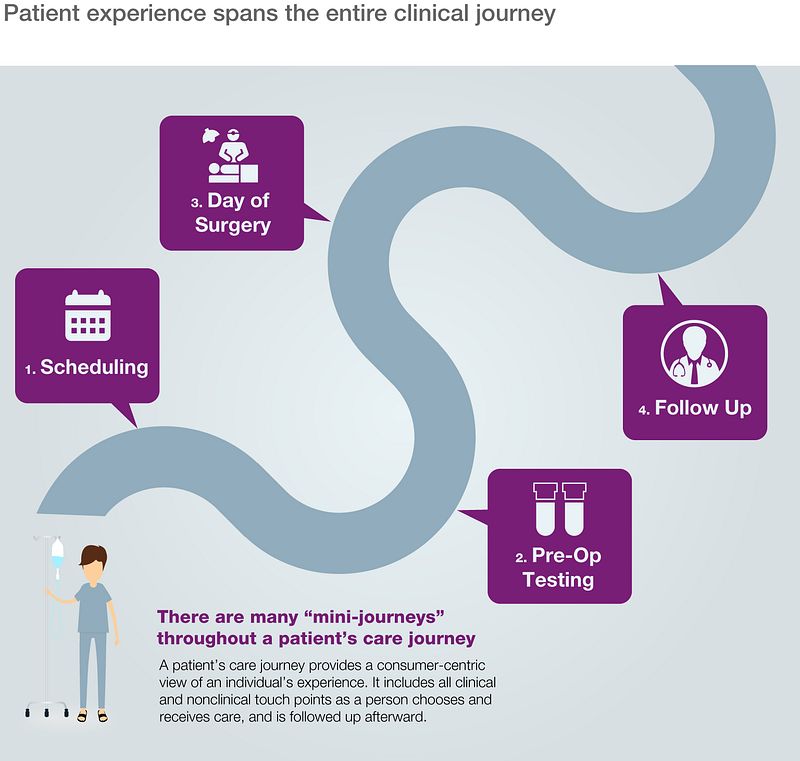As patient feedback becomes a more critical part of hospital performance, many hospitals and healthcare systems have made investments in improving the patient experience. Consumer trends are adding fuel to the fire — thanks to services-focused technology companies like Lyft and AirBnB, consumers expect and in many cases demand good experiences. Healthcare is of course different in many ways from these consumer industries — patients in hospitals can be in highly stressful situations, and in many cases, may not have any say in where they get their care. Despite these differences, it’s foolish to assume that patient experience can be neglected. Human preferences and expectations are deeply embedded in our psyche, even across contexts, and this fact hasn’t been lost on many of healthcare’s biggest players.
Lessons from AirBnB
However, with a few exceptions (like Oscar Health, which has always been strongly user-experience focused), the healthcare industry is thinking about patient experience far too narrowly or still not prioritizing it at all. Far too often, the patient experience is defined as what happens to the patient when they enter the hospital doors, to when they leave the hospital. If you don’t see something wrong with this definition, I encourage you to listen to Reid Hoffman’s brilliant new podcast, Masters of Scale, in which he interviews Brian Chesky about how and why AirBnB’s core product evolved over time:
CHESKY: I often find that to reinvent an industry, you do not take inspiration directly from that industry, you need to look at orthogonal industries. For us the orthogonal industry for travel was cinema. The best trips you’ve ever seen are the trips that characters in movies have and we would provide that analogy in real life. I actually literally hired a storyboard artist from Pixar. We had him storyboard the perfect Airbnb experience. When we did that we realized there was this two hour movie and only 20- minutes were in the home. There was all this leading up to the home, getting the airport, going around, going to dinner, or hanging out with friends out and about. Most of the trip was not in the home. We realized at that point, we need to be the end-to-end business of travel. So the same way that we did things that don’t scale, we called it “magical trips.” We decided let’s find one traveler and create the perfect trip for them.
Beyond the Hospital
One can see the problem with thinking that the patient’s experience is bounded by their arrival and departure from the hospital. When I worked on surgical services, this issue became clear as patients and families struggled to arrive at the hospital at the right time for pre-op, delaying surgeries and making everybody unhappy. When asked what happened, many patients families couldn’t find parking, or didn’t know where to check in. In our outpatient clinics, patients might fail to pick up prescription refills, but we’d have no way of knowing until their next appointment months later that it was because the pharmacy we ordered the meds to be prepared at was too far for them to travel to without reliable transport.
By thinking about the patient experience as existing only within the hospital, we neglect essential parts of the patient’s journey that have a material impact on their health, and the efficiency of our providers. We encourage innovators to think about the patient journey beyond the walls of the hospital. It’s true that budget and staffing limits what experiences a hospital can actually influence, but the important thing is to perform the thought exercise as an organization, and embed this mode of thinking into the culture. There are many touch-points that a hospital can still influence, as reflected in this infographic from a 2015 McKinsey & Co piece on patient experience:

Hospitals don’t always have to stretch beyond their core competency to address these “mini-journeys”. They can find partners who specialize in services outside the traditional patient journey. Recently, Blue Cross and Blue Shield announced a partnership with ridesharing giant, Lyft to tackle the problem of patient transportation. Cedars Sinai hospital is leveraging Virtual Reality to educate patients in a south LA Church. This is not a traditional part of the patient experience, but church is a significant and influential force in many patients’ lives — and ultimately, it’s a part of their primary care journey. Healthcare organizations that want to keep up with patient expectations need to examine all parts of the patient experience, from the moment an appointment is made, to the days leading up to it, to the ride to the clinic or hospital itself. They should look beyond discharge, and think critically about what happens to the patient between when they leave and when they follow up. This shift to a comprehensive patient-journey focus will be a critical exercise for healthcare organizations who wish to remain relevant and cutting edge in the years to come.
— Ben Nguyen, Digital Health Strategist
Ben is a medical student at the Keck School of Medicine of USC, where in addition to medicine, he studied medical device development, product design, and business strategy at Marshall and Viterbi as part of the HTE@USC program. Prior to joining Sidebench, Ben worked at the USC Center for Body Computing, a digital health research division and think tank, where his projects involved everything from virtual human avatars to mobile chronic disease management to biometric sensors. Follow him on Twitter: @BDKnguyen
—
This article was originally published on Medium






